<p>Autoprefixer 能自动为 css 属性添加 浏览器 厂商前缀,基于 Can I Use 数据和目标浏览器配置,通过 npm 安装并集成到 postcss、webpack 等构建 工具 中,在 package.json 或 .browserslistrc 中设置浏览器规则(如 >1%、IE >=10),再于 postcss.config.js 引入插件,处理后可将现代 CSS 转为兼容性代码,例如为 flex、transition 等属性补全 –webkit-、-moz- 等前缀,一次配置即可自动维护。</p>

Autoprefixer 是一个强大的 CSS 后处理 工具 ,能自动为 CSS 属性添加 浏览器 厂商前缀(如 -webkit-、-moz-、-ms- 等),让你无需手动管理兼容性问题。它基于 Can I Use 的数据,根据你指定的目标浏览器自动决定需要加哪些前缀。
安装 Autoprefixer
Autoprefixer 通常与构建工具(如 Webpack、gulp、PostCSS)配合使用。最常见的方式是通过 npm 安装:
- npm install autoprefixer postcss –save-dev
如果你使用的是 PostCSS,还需要在 配置文件 中引入 Autoprefixer 插件。
配置目标浏览器
Autoprefixer 能否正确添加前缀,关键在于如何设置支持的浏览器范围。可以通过以下方式之一配置:
立即学习 “ 前端免费学习笔记(深入)”;
- 在 package.json 中添加 browserlist 字段
- 创建 .browserslistrc 文件
示例配置(支持全球使用率大于 1% 的浏览器,且 IE >= 10):
> 1% IE >= 10
这样 Autoprefixer 就会根据这些规则自动判断是否需要添加前缀。
在项目中集成 Autoprefixer
以 PostCSS 为例,在构建流程中加入 Autoprefixer 非常简单。例如在 postcss.config.js 中写入:
module.exports = {plugins: [ require('autoprefixer') ] } </font>然后在 Webpack 或 Gulp 中调用 PostCSS 处理 CSS 文件,前缀就会自动生成。
实际效果示例
假设你写了如下现代 CSS:
.example {display: flex; transition: all 0.3s; user-select: none;}
经过 Autoprefixer 处理后,输出可能变成:
.example {display: -webkit-box; display: -ms-flexbox; display: flex; -webkit-transition: all 0.3s; transition: all 0.3s; -webkit-user-select: none; -moz-user-select: none; -ms-user-select: none; user-select: none;}
具体输出取决于你的浏览器支持策略。
基本上就这些。配置一次后,Autoprefixer 会默默帮你处理所有兼容性前缀,省时又可靠。不复杂但容易忽略。



